| Listing 1 - 10 of 12 | << page >> |
Sort by
|
Book
ISBN: 3039281771 3039281763 Year: 2020 Publisher: MDPI - Multidisciplinary Digital Publishing Institute
Abstract | Keywords | Export | Availability | Bookmark
 Loading...
Loading...Choose an application
- Reference Manager
- EndNote
- RefWorks (Direct export to RefWorks)
Research without statistics is like water in the sand; the latter is necessary to reap the benefits of the former. This collection of articles is designed to bring together different approaches to applied statistics. The studies presented in this book are a tiny piece of what applied statistics means and how statistical methods find their usefulness in different fields of research from theoretical frames to practical applications such as genetics, computational chemistry, and experimental design. This book presents several applications of the statistics: A new continuous distribution with five parameters—the modified beta Gompertz distribution; A method to calculate the p-value associated with the Anderson–Darling statistic; An approach of repeated measurement designs; A validated model to predict statement mutations score; A new family of structural descriptors, called the extending characteristic polynomial (EChP) family, used to express the link between the structure of a compound and its properties. This collection brings together authors from Europe and Asia with a specific contribution to the knowledge in regards to theoretical and applied statistics.
molecular descriptors --- compound symmetry --- Anderson–Darling test (AD) --- software testing --- probability --- characteristic polynomial (ChP) --- mutation testing --- C20 fullerene --- fullerene congeners --- machine learning --- maximum likelihood estimation --- gompertz distribution --- modified beta generator --- structure–property relationships --- repeated measurement designs --- Monte Carlo simulation
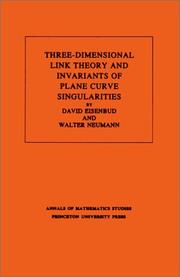
ISBN: 0691083819 0691083800 1400881927 9780691083810 9780691083803 Year: 1985 Volume: 110 Publisher: Princeton (N.J.): Princeton university press,
Abstract | Keywords | Export | Availability | Bookmark
 Loading...
Loading...Choose an application
- Reference Manager
- EndNote
- RefWorks (Direct export to RefWorks)
This book gives a new foundation for the theory of links in 3-space modeled on the modern developmentby Jaco, Shalen, Johannson, Thurston et al. of the theory of 3-manifolds. The basic construction is a method of obtaining any link by "splicing" links of the simplest kinds, namely those whose exteriors are Seifert fibered or hyperbolic. This approach to link theory is particularly attractive since most invariants of links are additive under splicing.Specially distinguished from this viewpoint is the class of links, none of whose splice components is hyperbolic. It includes all links constructed by cabling and connected sums, in particular all links of singularities of complex plane curves. One of the main contributions of this monograph is the calculation of invariants of these classes of links, such as the Alexander polynomials, monodromy, and Seifert forms.
Algebraic geometry --- Differential geometry. Global analysis --- Link theory. --- Curves, Plane. --- SINGULARITIES (Mathematics) --- Curves, Plane --- Invariants --- Link theory --- Singularities (Mathematics) --- Geometry, Algebraic --- Low-dimensional topology --- Piecewise linear topology --- Higher plane curves --- Plane curves --- Invariants. --- 3-sphere. --- Alexander Grothendieck. --- Alexander polynomial. --- Algebraic curve. --- Algebraic equation. --- Algebraic geometry. --- Algebraic surface. --- Algorithm. --- Ambient space. --- Analytic function. --- Approximation. --- Big O notation. --- Call graph. --- Cartesian coordinate system. --- Characteristic polynomial. --- Closed-form expression. --- Cohomology. --- Computation. --- Conjecture. --- Connected sum. --- Contradiction. --- Coprime integers. --- Corollary. --- Curve. --- Cyclic group. --- Determinant. --- Diagram (category theory). --- Diffeomorphism. --- Dimension. --- Disjoint union. --- Eigenvalues and eigenvectors. --- Equation. --- Equivalence class. --- Euler number. --- Existential quantification. --- Exterior (topology). --- Fiber bundle. --- Fibration. --- Foliation. --- Fundamental group. --- Geometry. --- Graph (discrete mathematics). --- Ground field. --- Homeomorphism. --- Homology sphere. --- Identity matrix. --- Integer matrix. --- Intersection form (4-manifold). --- Isolated point. --- Isolated singularity. --- Jordan normal form. --- Knot theory. --- Mathematical induction. --- Monodromy matrix. --- Monodromy. --- N-sphere. --- Natural transformation. --- Newton polygon. --- Newton's method. --- Normal (geometry). --- Notation. --- Pairwise. --- Parametrization. --- Plane curve. --- Polynomial. --- Power series. --- Projective plane. --- Puiseux series. --- Quantity. --- Rational function. --- Resolution of singularities. --- Riemann sphere. --- Riemann surface. --- Root of unity. --- Scientific notation. --- Seifert surface. --- Set (mathematics). --- Sign (mathematics). --- Solid torus. --- Special case. --- Stereographic projection. --- Submanifold. --- Summation. --- Theorem. --- Three-dimensional space (mathematics). --- Topology. --- Torus knot. --- Torus. --- Tubular neighborhood. --- Unit circle. --- Unit vector. --- Unknot. --- Variable (mathematics).
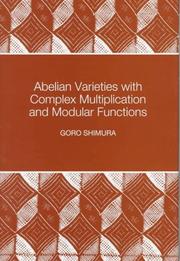
ISBN: 0691016569 1400883946 9780691016566 Year: 1998 Volume: 46 Publisher: Princeton (N.J.): Princeton university press,
Abstract | Keywords | Export | Availability | Bookmark
 Loading...
Loading...Choose an application
- Reference Manager
- EndNote
- RefWorks (Direct export to RefWorks)
Reciprocity laws of various kinds play a central role in number theory. In the easiest case, one obtains a transparent formulation by means of roots of unity, which are special values of exponential functions. A similar theory can be developed for special values of elliptic or elliptic modular functions, and is called complex multiplication of such functions. In 1900 Hilbert proposed the generalization of these as the twelfth of his famous problems. In this book, Goro Shimura provides the most comprehensive generalizations of this type by stating several reciprocity laws in terms of abelian varieties, theta functions, and modular functions of several variables, including Siegel modular functions. This subject is closely connected with the zeta function of an abelian variety, which is also covered as a main theme in the book. The third topic explored by Shimura is the various algebraic relations among the periods of abelian integrals. The investigation of such algebraicity is relatively new, but has attracted the interest of increasingly many researchers. Many of the topics discussed in this book have not been covered before. In particular, this is the first book in which the topics of various algebraic relations among the periods of abelian integrals, as well as the special values of theta and Siegel modular functions, are treated extensively.
Ordered algebraic structures --- 512.74 --- Abelian varieties --- Modular functions --- Functions, Modular --- Elliptic functions --- Group theory --- Number theory --- Varieties, Abelian --- Geometry, Algebraic --- Algebraic groups. Abelian varieties --- 512.74 Algebraic groups. Abelian varieties --- Abelian varieties. --- Modular functions. --- Abelian extension. --- Abelian group. --- Abelian variety. --- Absolute value. --- Adele ring. --- Affine space. --- Affine variety. --- Algebraic closure. --- Algebraic equation. --- Algebraic extension. --- Algebraic number field. --- Algebraic structure. --- Algebraic variety. --- Analytic manifold. --- Automorphic function. --- Automorphism. --- Big O notation. --- CM-field. --- Characteristic polynomial. --- Class field theory. --- Coefficient. --- Complete variety. --- Complex conjugate. --- Complex multiplication. --- Complex number. --- Complex torus. --- Corollary. --- Degenerate bilinear form. --- Differential form. --- Direct product. --- Direct proof. --- Discrete valuation ring. --- Divisor. --- Eigenvalues and eigenvectors. --- Embedding. --- Endomorphism. --- Existential quantification. --- Field of fractions. --- Finite field. --- Fractional ideal. --- Function (mathematics). --- Fundamental theorem. --- Galois extension. --- Galois group. --- Galois theory. --- Generic point. --- Ground field. --- Group theory. --- Groupoid. --- Hecke character. --- Homology (mathematics). --- Homomorphism. --- Identity element. --- Integer. --- Irreducibility (mathematics). --- Irreducible representation. --- Lie group. --- Linear combination. --- Linear subspace. --- Local ring. --- Modular form. --- Natural number. --- Number theory. --- Polynomial. --- Prime factor. --- Prime ideal. --- Projective space. --- Projective variety. --- Rational function. --- Rational mapping. --- Rational number. --- Real number. --- Residue field. --- Riemann hypothesis. --- Root of unity. --- Scientific notation. --- Semisimple algebra. --- Simple algebra. --- Singular value. --- Special case. --- Subgroup. --- Subring. --- Subset. --- Summation. --- Theorem. --- Vector space. --- Zero element.

ISBN: 0691032165 140088392X 9780691032160 Year: 1993 Volume: 43 Publisher: Princeton (N.J.): Princeton university press,
Abstract | Keywords | Export | Availability | Bookmark
 Loading...
Loading...Choose an application
- Reference Manager
- EndNote
- RefWorks (Direct export to RefWorks)
This book contains an exposition of some of the main developments of the last twenty years in the following areas of harmonic analysis: singular integral and pseudo-differential operators, the theory of Hardy spaces, Lsup estimates involving oscillatory integrals and Fourier integral operators, relations of curvature to maximal inequalities, and connections with analysis on the Heisenberg group.
Harmonic analysis. Fourier analysis --- Harmonic analysis --- Analyse harmonique --- Harmonic analysis. --- Analysis (Mathematics) --- Functions, Potential --- Potential functions --- Banach algebras --- Calculus --- Mathematical analysis --- Mathematics --- Bessel functions --- Fourier series --- Harmonic functions --- Time-series analysis --- Groupe de Heisenberg. --- Addition. --- Analytic function. --- Asymptote. --- Asymptotic analysis. --- Asymptotic expansion. --- Asymptotic formula. --- Automorphism. --- Axiom. --- Banach space. --- Bessel function. --- Big O notation. --- Bilinear form. --- Borel measure. --- Boundary value problem. --- Bounded function. --- Bounded mean oscillation. --- Bounded operator. --- Boundedness. --- Cancellation property. --- Cauchy's integral theorem. --- Cauchy–Riemann equations. --- Characteristic polynomial. --- Characterization (mathematics). --- Commutative property. --- Commutator. --- Complex analysis. --- Convolution. --- Differential equation. --- Differential operator. --- Dimension (vector space). --- Dimension. --- Dirac delta function. --- Dirichlet problem. --- Elliptic operator. --- Existential quantification. --- Fatou's theorem. --- Fourier analysis. --- Fourier integral operator. --- Fourier inversion theorem. --- Fourier series. --- Fourier transform. --- Fubini's theorem. --- Function (mathematics). --- Fundamental solution. --- Gaussian curvature. --- Hardy space. --- Harmonic function. --- Heisenberg group. --- Hilbert space. --- Hilbert transform. --- Holomorphic function. --- Hölder's inequality. --- Infimum and supremum. --- Integral transform. --- Interpolation theorem. --- Lagrangian (field theory). --- Laplace's equation. --- Lebesgue measure. --- Lie algebra. --- Line segment. --- Linear map. --- Lipschitz continuity. --- Locally integrable function. --- Marcinkiewicz interpolation theorem. --- Martingale (probability theory). --- Mathematical induction. --- Maximal function. --- Meromorphic function. --- Multiplication operator. --- Nilpotent Lie algebra. --- Norm (mathematics). --- Number theory. --- Operator theory. --- Order of integration (calculus). --- Orthogonality. --- Oscillatory integral. --- Poisson summation formula. --- Projection (linear algebra). --- Pseudo-differential operator. --- Pseudoconvexity. --- Rectangle. --- Riesz transform. --- Several complex variables. --- Sign (mathematics). --- Singular integral. --- Sobolev space. --- Special case. --- Spectral theory. --- Square (algebra). --- Stochastic differential equation. --- Subharmonic function. --- Submanifold. --- Summation. --- Support (mathematics). --- Theorem. --- Translational symmetry. --- Uniqueness theorem. --- Variable (mathematics). --- Vector field. --- Fourier, Analyse de --- Fourier, Opérateurs intégraux de
Book
ISBN: 9780691143415 0691143412 9786612458019 1282936077 1282458019 1400833884 9781400833887 9781282458017 9781282936072 Year: 2010 Publisher: Princeton, N.J. : Princeton University Press,
Abstract | Keywords | Export | Availability | Bookmark
 Loading...
Loading...Choose an application
- Reference Manager
- EndNote
- RefWorks (Direct export to RefWorks)
This computationally oriented book describes and explains the mathematical relationships among matrices, moments, orthogonal polynomials, quadrature rules, and the Lanczos and conjugate gradient algorithms. The book bridges different mathematical areas to obtain algorithms to estimate bilinear forms involving two vectors and a function of the matrix. The first part of the book provides the necessary mathematical background and explains the theory. The second part describes the applications and gives numerical examples of the algorithms and techniques developed in the first part. Applications addressed in the book include computing elements of functions of matrices; obtaining estimates of the error norm in iterative methods for solving linear systems and computing parameters in least squares and total least squares; and solving ill-posed problems using Tikhonov regularization. This book will interest researchers in numerical linear algebra and matrix computations, as well as scientists and engineers working on problems involving computation of bilinear forms.
Matrices. --- Numerical analysis. --- Mathematical analysis --- Algebra, Matrix --- Cracovians (Mathematics) --- Matrix algebra --- Matrixes (Algebra) --- Algebra, Abstract --- Algebra, Universal --- Matrices --- Numerical analysis --- Algorithm. --- Analysis of algorithms. --- Analytic function. --- Asymptotic analysis. --- Basis (linear algebra). --- Basis function. --- Biconjugate gradient method. --- Bidiagonal matrix. --- Bilinear form. --- Calculation. --- Characteristic polynomial. --- Chebyshev polynomials. --- Coefficient. --- Complex number. --- Computation. --- Condition number. --- Conjugate gradient method. --- Conjugate transpose. --- Cross-validation (statistics). --- Curve fitting. --- Degeneracy (mathematics). --- Determinant. --- Diagonal matrix. --- Dimension (vector space). --- Eigenvalues and eigenvectors. --- Equation. --- Estimation. --- Estimator. --- Exponential function. --- Factorization. --- Function (mathematics). --- Function of a real variable. --- Functional analysis. --- Gaussian quadrature. --- Hankel matrix. --- Hermite interpolation. --- Hessenberg matrix. --- Hilbert matrix. --- Holomorphic function. --- Identity matrix. --- Interlacing (bitmaps). --- Inverse iteration. --- Inverse problem. --- Invertible matrix. --- Iteration. --- Iterative method. --- Jacobi matrix. --- Krylov subspace. --- Laguerre polynomials. --- Lanczos algorithm. --- Linear differential equation. --- Linear regression. --- Linear subspace. --- Logarithm. --- Machine epsilon. --- Matrix function. --- Matrix polynomial. --- Maxima and minima. --- Mean value theorem. --- Meromorphic function. --- Moment (mathematics). --- Moment matrix. --- Moment problem. --- Monic polynomial. --- Monomial. --- Monotonic function. --- Newton's method. --- Numerical integration. --- Numerical linear algebra. --- Orthogonal basis. --- Orthogonal matrix. --- Orthogonal polynomials. --- Orthogonal transformation. --- Orthogonality. --- Orthogonalization. --- Orthonormal basis. --- Partial fraction decomposition. --- Polynomial. --- Preconditioner. --- QR algorithm. --- QR decomposition. --- Quadratic form. --- Rate of convergence. --- Recurrence relation. --- Regularization (mathematics). --- Rotation matrix. --- Singular value. --- Square (algebra). --- Summation. --- Symmetric matrix. --- Theorem. --- Tikhonov regularization. --- Trace (linear algebra). --- Triangular matrix. --- Tridiagonal matrix. --- Upper and lower bounds. --- Variable (mathematics). --- Vector space. --- Weight function.
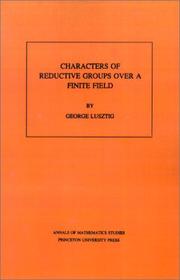
ISBN: 0691083509 0691083517 1400881773 9780691083513 9780691083506 Year: 1984 Volume: 107 Publisher: Princeton (N.J.): Princeton university press,
Abstract | Keywords | Export | Availability | Bookmark
 Loading...
Loading...Choose an application
- Reference Manager
- EndNote
- RefWorks (Direct export to RefWorks)
This book presents a classification of all (complex)irreducible representations of a reductive group withconnected centre, over a finite field. To achieve this,the author uses etale intersection cohomology, anddetailed information on representations of Weylgroups.
512 --- Characters of groups --- Finite fields (Algebra) --- Finite groups --- Groups, Finite --- Group theory --- Modules (Algebra) --- Modular fields (Algebra) --- Algebra, Abstract --- Algebraic fields --- Galois theory --- Characters, Group --- Group characters --- Groups, Characters of --- Representations of groups --- Rings (Algebra) --- Algebra --- 512 Algebra --- Finite groups. --- Characters of groups. --- Addition. --- Algebra representation. --- Algebraic closure. --- Algebraic group. --- Algebraic variety. --- Algebraically closed field. --- Bijection. --- Borel subgroup. --- Cartan subalgebra. --- Character table. --- Character theory. --- Characteristic function (probability theory). --- Characteristic polynomial. --- Class function (algebra). --- Classical group. --- Coefficient. --- Cohomology with compact support. --- Cohomology. --- Combination. --- Complex number. --- Computation. --- Conjugacy class. --- Connected component (graph theory). --- Coxeter group. --- Cyclic group. --- Cyclotomic polynomial. --- David Kazhdan. --- Dense set. --- Derived category. --- Diagram (category theory). --- Dimension. --- Direct sum. --- Disjoint sets. --- Disjoint union. --- E6 (mathematics). --- Eigenvalues and eigenvectors. --- Endomorphism. --- Equivalence class. --- Equivalence relation. --- Existential quantification. --- Explicit formula. --- Explicit formulae (L-function). --- Fiber bundle. --- Finite field. --- Finite group. --- Fourier transform. --- Green's function. --- Group (mathematics). --- Group action. --- Group representation. --- Harish-Chandra. --- Hecke algebra. --- Identity element. --- Integer. --- Irreducible representation. --- Isomorphism class. --- Jordan decomposition. --- Line bundle. --- Linear combination. --- Local system. --- Mathematical induction. --- Maximal torus. --- Module (mathematics). --- Monodromy. --- Morphism. --- Orthonormal basis. --- P-adic number. --- Parametrization. --- Parity (mathematics). --- Partially ordered set. --- Perverse sheaf. --- Pointwise. --- Polynomial. --- Quantity. --- Rational point. --- Reductive group. --- Ree group. --- Schubert variety. --- Scientific notation. --- Semisimple Lie algebra. --- Sheaf (mathematics). --- Simple group. --- Simple module. --- Special case. --- Standard basis. --- Subset. --- Subtraction. --- Summation. --- Surjective function. --- Symmetric group. --- Tensor product. --- Theorem. --- Two-dimensional space. --- Unipotent representation. --- Vector bundle. --- Vector space. --- Verma module. --- Weil conjecture. --- Weyl group. --- Zariski topology.
Book
ISBN: 0691082189 1322886407 0691628084 0691648328 1400867312 Year: 1978 Publisher: Princeton, N.J.
Abstract | Keywords | Export | Availability | Bookmark
 Loading...
Loading...Choose an application
- Reference Manager
- EndNote
- RefWorks (Direct export to RefWorks)
Written by Arthur Ogus on the basis of notes from Pierre Berthelot's seminar on crystalline cohomology at Princeton University in the spring of 1974, this book constitutes an informal introduction to a significant branch of algebraic geometry. Specifically, it provides the basic tools used in the study of crystalline cohomology of algebraic varieties in positive characteristic.Originally published in 1978.The Princeton Legacy Library uses the latest print-on-demand technology to again make available previously out-of-print books from the distinguished backlist of Princeton University Press. These editions preserve the original texts of these important books while presenting them in durable paperback and hardcover editions. The goal of the Princeton Legacy Library is to vastly increase access to the rich scholarly heritage found in the thousands of books published by Princeton University Press since its founding in 1905.
Algebraic geometry --- Geometry, Algebraic. --- Homology theory. --- Functions, Zeta. --- Zeta functions --- Cohomology theory --- Contrahomology theory --- Algebraic topology --- Geometry --- Abelian category. --- Additive map. --- Adjoint functors. --- Adjunction (field theory). --- Adjunction formula. --- Alexander Grothendieck. --- Algebra homomorphism. --- Artinian. --- Automorphism. --- Axiom. --- Banach space. --- Base change map. --- Base change. --- Betti number. --- Calculation. --- Cartesian product. --- Category of abelian groups. --- Characteristic polynomial. --- Characterization (mathematics). --- Closed immersion. --- Codimension. --- Coefficient. --- Cohomology. --- Cokernel. --- Commutative diagram. --- Commutative property. --- Commutative ring. --- Compact space. --- Corollary. --- Crystalline cohomology. --- De Rham cohomology. --- Degeneracy (mathematics). --- Derived category. --- Diagram (category theory). --- Differential operator. --- Discrete valuation ring. --- Divisibility rule. --- Dual basis. --- Eigenvalues and eigenvectors. --- Endomorphism. --- Epimorphism. --- Equation. --- Equivalence of categories. --- Exact sequence. --- Existential quantification. --- Explicit formula. --- Explicit formulae (L-function). --- Exponential type. --- Exterior algebra. --- Exterior derivative. --- Formal power series. --- Formal scheme. --- Frobenius endomorphism. --- Functor. --- Fundamental theorem. --- Hasse invariant. --- Hodge theory. --- Homotopy. --- Ideal (ring theory). --- Initial and terminal objects. --- Inverse image functor. --- Inverse limit. --- Inverse system. --- K-theory. --- Leray spectral sequence. --- Linear map. --- Linearization. --- Locally constant function. --- Mapping cone (homological algebra). --- Mathematical induction. --- Maximal ideal. --- Module (mathematics). --- Monomial. --- Monotonic function. --- Morphism. --- Natural transformation. --- Newton polygon. --- Noetherian ring. --- Noetherian. --- P-adic number. --- Polynomial. --- Power series. --- Presheaf (category theory). --- Projective module. --- Scientific notation. --- Series (mathematics). --- Sheaf (mathematics). --- Sheaf of modules. --- Special case. --- Spectral sequence. --- Subring. --- Subset. --- Symmetric algebra. --- Theorem. --- Topological space. --- Topology. --- Topos. --- Transitive relation. --- Universal property. --- Zariski topology. --- Geometrie algebrique --- Topologie algebrique --- Varietes algebriques --- Cohomologie

ISBN: 0691005478 0691080046 1400883865 9780691080048 9780691005478 Year: 1974 Volume: 9 Publisher: Princeton (N.J.): Princeton university press,
Abstract | Keywords | Export | Availability | Bookmark
 Loading...
Loading...Choose an application
- Reference Manager
- EndNote
- RefWorks (Direct export to RefWorks)
In this classic of statistical mathematical theory, Harald Cramér joins the two major lines of development in the field: while British and American statisticians were developing the science of statistical inference, French and Russian probabilitists transformed the classical calculus of probability into a rigorous and pure mathematical theory. The result of Cramér's work is a masterly exposition of the mathematical methods of modern statistics that set the standard that others have since sought to follow. For anyone with a working knowledge of undergraduate mathematics the book is self contained. The first part is an introduction to the fundamental concept of a distribution and of integration with respect to a distribution. The second part contains the general theory of random variables and probability distributions while the third is devoted to the theory of sampling, statistical estimation, and tests of significance.
Mathematical statistics --- 519.2 --- 519.2 Probability. Mathematical statistics --- Probability. Mathematical statistics --- Mathematics --- Statistical inference --- Statistics, Mathematical --- Statistics --- Probabilities --- Sampling (Statistics) --- Statistical methods --- Statistique mathématique --- Mathematical statistics. --- Statistique mathématique --- Statistique mathématique. --- Distribution (théorie des probabilités) --- Distribution (Probability theory) --- A priori probability. --- Addition theorem. --- Additive function. --- Analysis of covariance. --- Arithmetic mean. --- Axiom. --- Bayes' theorem. --- Bias of an estimator. --- Binomial distribution. --- Binomial theorem. --- Bolzano–Weierstrass theorem. --- Borel set. --- Bounded set (topological vector space). --- Calculation. --- Cartesian product. --- Central moment. --- Characteristic function (probability theory). --- Characteristic polynomial. --- Coefficient. --- Commutative property. --- Confidence interval. --- Convergence of random variables. --- Correlation coefficient. --- Degeneracy (mathematics). --- Degrees of freedom (statistics). --- Diagram (category theory). --- Dimension. --- Distribution (mathematics). --- Distribution function. --- Empirical distribution function. --- Equation. --- Estimation theory. --- Estimation. --- Identity matrix. --- Independence (probability theory). --- Interval (mathematics). --- Inverse probability. --- Invertible matrix. --- Joint probability distribution. --- Laplace distribution. --- Lebesgue integration. --- Lebesgue measure. --- Lebesgue–Stieltjes integration. --- Likelihood function. --- Limit (mathematics). --- Linear regression. --- Logarithm. --- Logarithmic derivative. --- Logarithmic scale. --- Marginal distribution. --- Mathematical analysis. --- Mathematical induction. --- Mathematical theory. --- Mathematics. --- Matrix (mathematics). --- Maxima and minima. --- Measure (mathematics). --- Method of moments (statistics). --- Metric space. --- Minor (linear algebra). --- Moment (mathematics). --- Moment matrix. --- Normal distribution. --- Numerical analysis. --- Parameter. --- Parity (mathematics). --- Poisson distribution. --- Probability distribution. --- Probability theory. --- Probability. --- Proportionality (mathematics). --- Quantity. --- Random variable. --- Realization (probability). --- Riemann integral. --- Sample space. --- Sampling (statistics). --- Scientific notation. --- Series (mathematics). --- Set (mathematics). --- Set function. --- Sign (mathematics). --- Standard deviation. --- Statistic. --- Statistical Science. --- Statistical hypothesis testing. --- Statistical inference. --- Statistical regularity. --- Statistical theory. --- Subset. --- Summation. --- Theorem. --- Theory. --- Transfinite number. --- Uniform distribution (discrete). --- Variable (mathematics). --- Variance. --- Weighted arithmetic mean. --- Z-test. --- Distribution (théorie des probabilités)
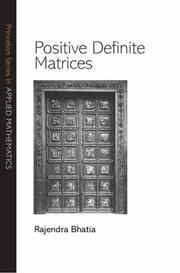
ISBN: 1282129740 9786612129742 1400827787 9781400827787 9781282129740 0691129185 9780691129181 6612129743 Year: 2007 Publisher: Princeton, N.J. : Princeton University Press,
Abstract | Keywords | Export | Availability | Bookmark
 Loading...
Loading...Choose an application
- Reference Manager
- EndNote
- RefWorks (Direct export to RefWorks)
This book represents the first synthesis of the considerable body of new research into positive definite matrices. These matrices play the same role in noncommutative analysis as positive real numbers do in classical analysis. They have theoretical and computational uses across a broad spectrum of disciplines, including calculus, electrical engineering, statistics, physics, numerical analysis, quantum information theory, and geometry. Through detailed explanations and an authoritative and inspiring writing style, Rajendra Bhatia carefully develops general techniques that have wide applications in the study of such matrices. Bhatia introduces several key topics in functional analysis, operator theory, harmonic analysis, and differential geometry--all built around the central theme of positive definite matrices. He discusses positive and completely positive linear maps, and presents major theorems with simple and direct proofs. He examines matrix means and their applications, and shows how to use positive definite functions to derive operator inequalities that he and others proved in recent years. He guides the reader through the differential geometry of the manifold of positive definite matrices, and explains recent work on the geometric mean of several matrices. Positive Definite Matrices is an informative and useful reference book for mathematicians and other researchers and practitioners. The numerous exercises and notes at the end of each chapter also make it the ideal textbook for graduate-level courses.
Matrices. --- Algebra, Matrix --- Cracovians (Mathematics) --- Matrix algebra --- Matrixes (Algebra) --- Algebra, Abstract --- Algebra, Universal --- Matrices --- 512.64 --- 512.64 Linear and multilinear algebra. Matrix theory --- Linear and multilinear algebra. Matrix theory --- Addition. --- Analytic continuation. --- Arithmetic mean. --- Banach space. --- Binomial theorem. --- Block matrix. --- Bochner's theorem. --- Calculation. --- Cauchy matrix. --- Cauchy–Schwarz inequality. --- Characteristic polynomial. --- Coefficient. --- Commutative property. --- Compact space. --- Completely positive map. --- Complex number. --- Computation. --- Continuous function. --- Convex combination. --- Convex function. --- Convex set. --- Corollary. --- Density matrix. --- Diagonal matrix. --- Differential geometry. --- Eigenvalues and eigenvectors. --- Equation. --- Equivalence relation. --- Existential quantification. --- Extreme point. --- Fourier transform. --- Functional analysis. --- Fundamental theorem. --- G. H. Hardy. --- Gamma function. --- Geometric mean. --- Geometry. --- Hadamard product (matrices). --- Hahn–Banach theorem. --- Harmonic analysis. --- Hermitian matrix. --- Hilbert space. --- Hyperbolic function. --- Infimum and supremum. --- Infinite divisibility (probability). --- Invertible matrix. --- Lecture. --- Linear algebra. --- Linear map. --- Logarithm. --- Logarithmic mean. --- Mathematics. --- Matrix (mathematics). --- Matrix analysis. --- Matrix unit. --- Metric space. --- Monotonic function. --- Natural number. --- Open set. --- Operator algebra. --- Operator system. --- Orthonormal basis. --- Partial trace. --- Positive definiteness. --- Positive element. --- Positive map. --- Positive semidefinite. --- Positive-definite function. --- Positive-definite matrix. --- Probability measure. --- Probability. --- Projection (linear algebra). --- Quantity. --- Quantum computing. --- Quantum information. --- Quantum statistical mechanics. --- Real number. --- Riccati equation. --- Riemannian geometry. --- Riemannian manifold. --- Riesz representation theorem. --- Right half-plane. --- Schur complement. --- Schur's theorem. --- Scientific notation. --- Self-adjoint operator. --- Sign (mathematics). --- Special case. --- Spectral theorem. --- Square root. --- Standard basis. --- Summation. --- Tensor product. --- Theorem. --- Toeplitz matrix. --- Unit vector. --- Unitary matrix. --- Unitary operator. --- Upper half-plane. --- Variable (mathematics).
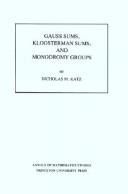
ISBN: 0691084335 0691084327 1400882125 Year: 1988 Volume: vol 116 Publisher: Princeton : Princeton University Press,
Abstract | Keywords | Export | Availability | Bookmark
 Loading...
Loading...Choose an application
- Reference Manager
- EndNote
- RefWorks (Direct export to RefWorks)
The study of exponential sums over finite fields, begun by Gauss nearly two centuries ago, has been completely transformed in recent years by advances in algebraic geometry, culminating in Deligne's work on the Weil Conjectures. It now appears as a very attractive mixture of algebraic geometry, representation theory, and the sheaf-theoretic incarnations of such standard constructions of classical analysis as convolution and Fourier transform. The book is simultaneously an account of some of these ideas, techniques, and results, and an account of their application to concrete equidistribution questions concerning Kloosterman sums and Gauss sums.
Group theory --- Algebraic geometry --- Number theory --- 511.33 --- Analytical and multiplicative number theory. Asymptotics. Sieves etc. --- 511.33 Analytical and multiplicative number theory. Asymptotics. Sieves etc. --- Gaussian sums --- Homology theory --- Kloosterman sums --- Monodromy groups --- Kloostermann sums --- Sums, Kloosterman --- Sums, Kloostermann --- Exponential sums --- Cohomology theory --- Contrahomology theory --- Algebraic topology --- Gauss sums --- Sums, Gaussian --- Analytical and multiplicative number theory. Asymptotics. Sieves etc --- Gaussian sums. --- Kloosterman sums. --- Homology theory. --- Monodromy groups. --- Number theory. --- Nombres, Théorie des. --- Exponential sums. --- Sommes exponentielles. --- Arithmetic --- Arithmétique --- Geometry, Algebraic. --- Géométrie algébrique --- Abelian category. --- Absolute Galois group. --- Absolute value. --- Additive group. --- Adjoint representation. --- Affine variety. --- Algebraic group. --- Automorphic form. --- Automorphism. --- Big O notation. --- Cartan subalgebra. --- Characteristic polynomial. --- Classification theorem. --- Coefficient. --- Cohomology. --- Cokernel. --- Combination. --- Commutator. --- Compactification (mathematics). --- Complex Lie group. --- Complex number. --- Conjugacy class. --- Continuous function. --- Convolution theorem. --- Convolution. --- Determinant. --- Diagonal matrix. --- Dimension (vector space). --- Direct sum. --- Dual basis. --- Eigenvalues and eigenvectors. --- Empty set. --- Endomorphism. --- Equidistribution theorem. --- Estimation. --- Exactness. --- Existential quantification. --- Exponential sum. --- Exterior algebra. --- Faithful representation. --- Finite field. --- Finite group. --- Four-dimensional space. --- Frobenius endomorphism. --- Fundamental group. --- Fundamental representation. --- Galois group. --- Gauss sum. --- Homomorphism. --- Integer. --- Irreducibility (mathematics). --- Isomorphism class. --- Kloosterman sum. --- L-function. --- Leray spectral sequence. --- Lie algebra. --- Lie theory. --- Maximal compact subgroup. --- Method of moments (statistics). --- Monodromy theorem. --- Monodromy. --- Morphism. --- Multiplicative group. --- Natural number. --- Nilpotent. --- Open problem. --- P-group. --- Pairing. --- Parameter space. --- Parameter. --- Partially ordered set. --- Perfect field. --- Point at infinity. --- Polynomial ring. --- Prime number. --- Quotient group. --- Representation ring. --- Representation theory. --- Residue field. --- Riemann hypothesis. --- Root of unity. --- Sheaf (mathematics). --- Simple Lie group. --- Skew-symmetric matrix. --- Smooth morphism. --- Special case. --- Spin representation. --- Subgroup. --- Support (mathematics). --- Symmetric matrix. --- Symplectic group. --- Symplectic vector space. --- Tensor product. --- Theorem. --- Trace (linear algebra). --- Trivial representation. --- Variable (mathematics). --- Weil conjectures. --- Weyl character formula. --- Zariski topology. --- Geometry, Algebraic
| Listing 1 - 10 of 12 | << page >> |
Sort by
|

 Search
Search Feedback
Feedback About UniCat
About UniCat  Help
Help News
News